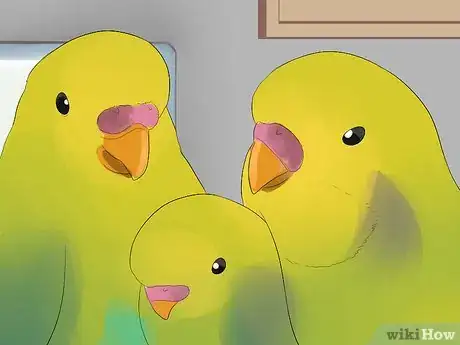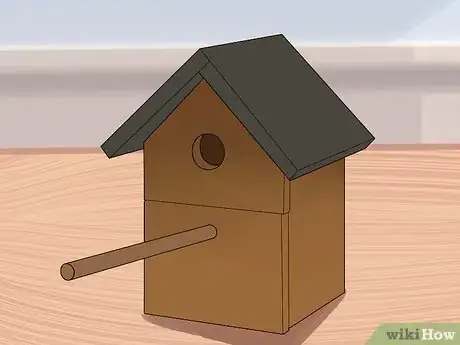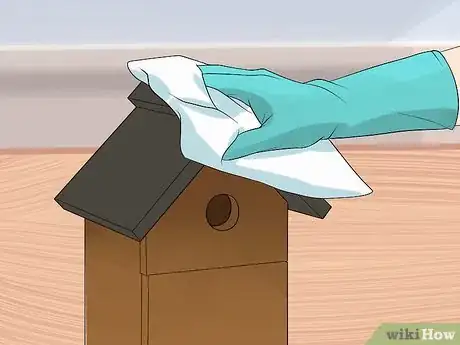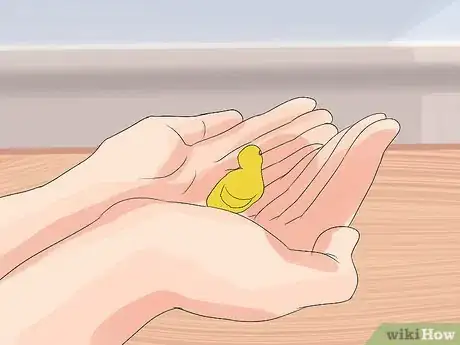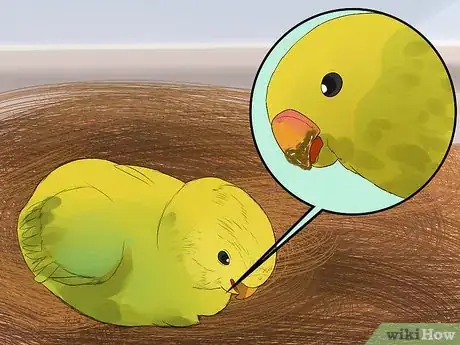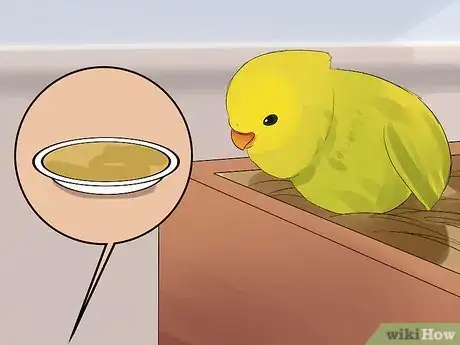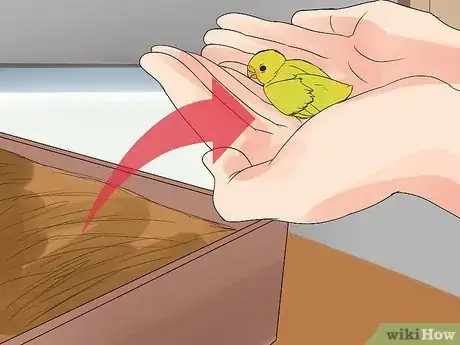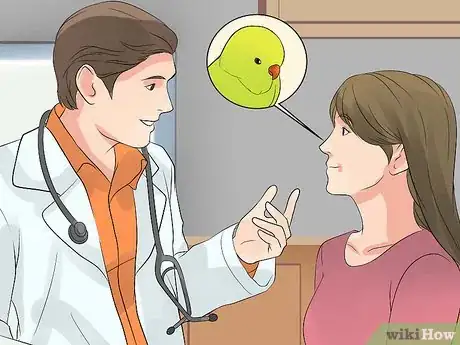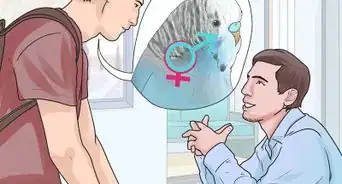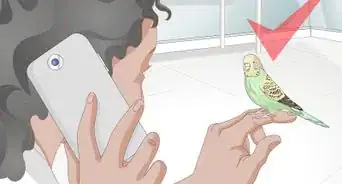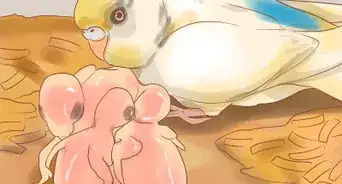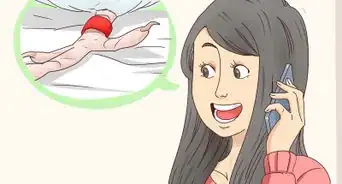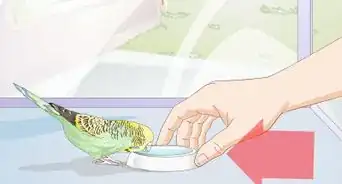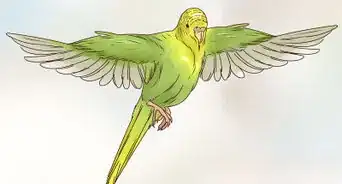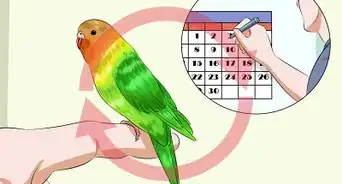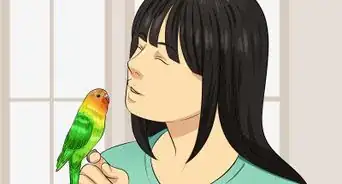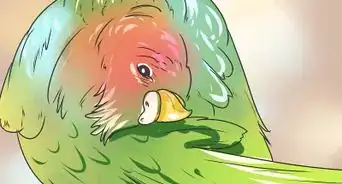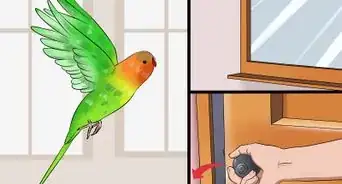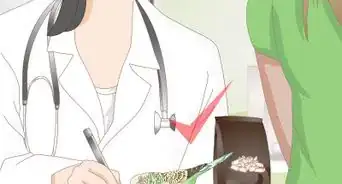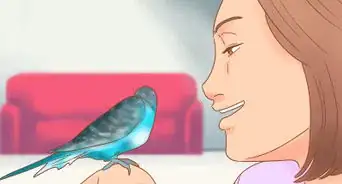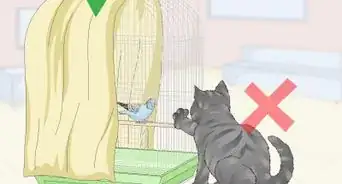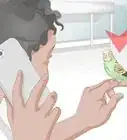This article was co-authored by Pippa Elliott, MRCVS. Dr. Elliott, BVMS, MRCVS is a veterinarian with over 30 years of experience in veterinary surgery and companion animal practice. She graduated from the University of Glasgow in 1987 with a degree in veterinary medicine and surgery. She has worked at the same animal clinic in her hometown for over 20 years.
wikiHow marks an article as reader-approved once it receives enough positive feedback. This article received 16 testimonials and 84% of readers who voted found it helpful, earning it our reader-approved status.
This article has been viewed 201,317 times.
If you have a new baby budgie, you can help him develop healthily and happily by being attentive and providing the right environment. Allow the parents to care for the chick in the first weeks, but lend a hand and monitor everything. Once the chick begins to leave the nest, you can facilitate the weaning process. Once the chick is ready, you can take him away from the nesting box.
Steps
Providing the Best Environment
-
1Let the parents care for newborns. If you have a baby budgie which you have bred from a pair of budgies at home, it's important to allow the parents to do most of the caring. Part of creating the best possible environment for the chick to thrive is helping the parents look after him. The parents are the real experts, so you should enable them to do the job. You should, however, always keep a close eye on how the chick is progressing.[1]
- Try to handle any chick as little as possible in the first couple of weeks especially.
- The chick will be incredibly fragile, with a long neck that cannot yet properly support his head. Be very gentle and move slowly when you handle him.
-
2Ensure a dry, dark, warm nesting box. The chicks are born blind and without feathers, so they are very vulnerable to environmental factors, such as light, heat, cold, and wet. They should stay in the nesting box for the first few weeks so they can develop in a protected area. Make sure that the nesting box is out of any direct light. There should be a good circulation of air, but the box should be warm and insulated from any drafts, cold or moisture.[2]
- A wooden box that has plenty of nesting material such as plain rolled oats or safe wood shavings in it makes a good nesting box. The parents will construct the nest, but having a safe, closed space like a wooden box can help them feel secure.
- A cardboard box is generally considered a bit too flimsy, and wood is preferable.
- There should be enough room for the birds to move around the box, but it should be small enough to still feel closed and secure.
- Place the box in the cage, but try not to interfere too much. Allow the parents to organise the nest. Having the nest attached outside the cage is the best option if possible as it allows the most space inside the cage.[3]
Advertisement -
3Keep the nesting box clean. The chick's parents will try to keep chicks clean, but you can help by making sure the chick's feet and beak don't get clogged up with soiled bedding or anything else.[4] Once the babies start getting feathered, you should begin cleaning out the nest box regularly. Keep an eye out for large build-ups of soiled bedding. Scoop these areas out and replace them with fresh bedding.
- You should also scrape clean the wooden insert on the base as needed.
- Try to clean out the nest once a week or more frequently if required.
- Place the chicks in a large bowl, which you have lined with a soft towel, while you are cleaning the nest box.[5]
Helping the Chick Develop
-
1Monitor the chick in the first days. The chick's parents will care for it as best as they can, but you should regularly check on the health and development of the chick. If the chick develops an illness, you may need to consult a veterinarian. By the time the chick is a few days old, it should show some bright colour, and should be beginning to put on weight. Generally a lighter chick is more disposed to illness or is being targeted by red mites.
- If your chick doesn't appear to be developing or gaining weight, consider contacting your vet or handfeeding if you can.
- Once your chick has begun to develop feathers, and they have reached about half an inch long (approximately 1cm), they should feel strong when you touch them.
-
2Check the babies for fixable developmental problems. If you think your chick is not developing properly, you should consult a vet for some expert advice, but there are some basic checks that you can do at home to help the chick develop healthily. The first of these is to look under the top mandible (beak). If you notice a build-up of food, this can lead to an undershot beak.
- If you see some food stuck there, very carefully remove it with a toothpick.
- If you think that your chick is beginning to develop splayed legs, try adding some extra bedding to the nest.[6]
- If the chick cannot stand up straight, perch, or walk around easily, he may have splayed legs. Look to see if the legs lean out to the sides rather than underneath the body.[7]
- If you are uncertain or you think your chick is ill, don't hesitate to contact your vet.
-
3Help the chick wean. Once the chick starts coming out of the nest on his own, you can help the process of weaning along, and then help him leave the nest. Once you notice the chick coming out of the nest, you should provide a shallow dish of food and place it at the bottom of the cage. The chick will start eating the food from the dish, beginning the weaning process.[8]
- You should allow the chick to wean by itself, but monitor it closely to ensure that it is eating enough.
- Provide a dish of fresh water so the chick can learn to drink from it.
- Monitor the chicks and parents; when they have not been fed by the parents for at least a week, have not asked for feeds and you can see they are cracking seeds and filling their crops well you can considered them weaned.
-
4Remove the chick from the nest. Once a chick is weaned you can remove him the from the nest. This will help his development and the development of any younger chicks in the nest. Put the weaned chick in a large cage that you have set aside for young birds. Ensure the cage has plenty of food placed in different areas, but especially in a dish at the bottom of the cage, and a supply of fresh water.
-
5Consult your vet. Once your chick is developed and independent, you can book him in for his first check-up with the vet. Bringing him to the vet will reduce the chances of a hidden problem developing. The vet will also be able to give you some good tips on how to care for a young bird. Before you go to the vet, it's a good idea to prepare yourself well.
- Write down a list of all the foods and supplements you are feeding your bird.
- Be able to describe the bird's living environment. Bring in photos if possible.[11]
Expert Q&A
Did you know you can get expert answers for this article?
Unlock expert answers by supporting wikiHow
-
QuestionWhen can I hold a baby budgie?
 Pippa Elliott, MRCVSDr. Elliott, BVMS, MRCVS is a veterinarian with over 30 years of experience in veterinary surgery and companion animal practice. She graduated from the University of Glasgow in 1987 with a degree in veterinary medicine and surgery. She has worked at the same animal clinic in her hometown for over 20 years.
Pippa Elliott, MRCVSDr. Elliott, BVMS, MRCVS is a veterinarian with over 30 years of experience in veterinary surgery and companion animal practice. She graduated from the University of Glasgow in 1987 with a degree in veterinary medicine and surgery. She has worked at the same animal clinic in her hometown for over 20 years.
Veterinarian
-
QuestionDo budgies make a good pet?
 Pippa Elliott, MRCVSDr. Elliott, BVMS, MRCVS is a veterinarian with over 30 years of experience in veterinary surgery and companion animal practice. She graduated from the University of Glasgow in 1987 with a degree in veterinary medicine and surgery. She has worked at the same animal clinic in her hometown for over 20 years.
Pippa Elliott, MRCVSDr. Elliott, BVMS, MRCVS is a veterinarian with over 30 years of experience in veterinary surgery and companion animal practice. She graduated from the University of Glasgow in 1987 with a degree in veterinary medicine and surgery. She has worked at the same animal clinic in her hometown for over 20 years.
Veterinarian
-
QuestionHow can I tell if my budgie is healthy or unhealthy?
 Pippa Elliott, MRCVSDr. Elliott, BVMS, MRCVS is a veterinarian with over 30 years of experience in veterinary surgery and companion animal practice. She graduated from the University of Glasgow in 1987 with a degree in veterinary medicine and surgery. She has worked at the same animal clinic in her hometown for over 20 years.
Pippa Elliott, MRCVSDr. Elliott, BVMS, MRCVS is a veterinarian with over 30 years of experience in veterinary surgery and companion animal practice. She graduated from the University of Glasgow in 1987 with a degree in veterinary medicine and surgery. She has worked at the same animal clinic in her hometown for over 20 years.
Veterinarian A healthy bird should be bright and alert, taking an interest in what's going on around it. Its face should be clean with no discharges from the eyes or cere. The feathers should be smooth and sleek, with a satin sheen rather than fluffed up. There should be no coughing or sneezing, and the poop should be white and black, rather than green or yellow. An unhealthy bird is often hunched or fluffed up, withdrawn, and may breathe more quickly than usual.
A healthy bird should be bright and alert, taking an interest in what's going on around it. Its face should be clean with no discharges from the eyes or cere. The feathers should be smooth and sleek, with a satin sheen rather than fluffed up. There should be no coughing or sneezing, and the poop should be white and black, rather than green or yellow. An unhealthy bird is often hunched or fluffed up, withdrawn, and may breathe more quickly than usual.
References
- ↑ http://animals.mom.me/care-baby-budgies-9246.html
- ↑ http://animals.mom.me/care-baby-budgies-9246.html
- ↑ http://animals.mom.me/build-budgie-nest-9079.html
- ↑ http://animals.mom.me/care-baby-budgies-9246.html
- ↑ http://budgieplace.com/breeding.html
- ↑ http://budgieplace.com/breeding.html
- ↑ http://www.petful.com/pet-health/caring-bird-with-splayed-legs/
- ↑ http://budgieplace.com/breeding.html
- ↑ http://budgieplace.com/breeding.html
About This Article
To care for your baby budgie, start by making sure the nesting box is clean, warm, and dry with good circulation. For the first couple of weeks, let the parents do most of the caring, and try to handle the chick as little as possible since it will be very fragile. Then, monitor the chick’s health, which will be indicated by gaining weight and showing some bright color. Once the chick starts coming out of the nest on its own, provide a shallow dish of food and water at the bottom of the cage to help the weaning process. For more tips from our Veterinary co-author, like how to know when to take your baby budgie to a vet, read on!
